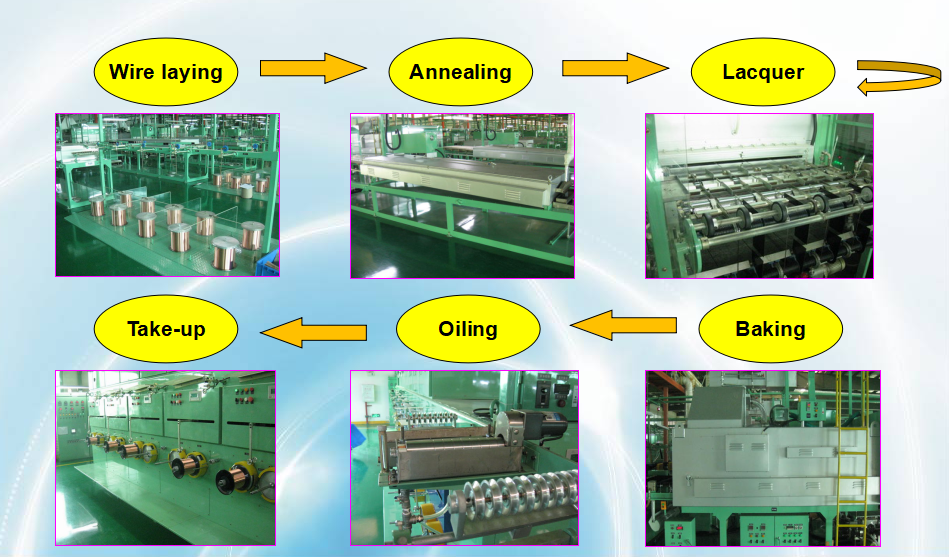Production process
I. Wire Drawing Procedure
Basic principle: A pressure machining method in which copper materials are subjected to plastic deformation through the drawing die under the action of tensile force to reduce circular and increase length. Coarse wire drawing→intermediate wire drawing→fine wire drawing→mini wire drawing→superfine wire drawing. Different Tech & Specifications meet the different customers’ demands.

- Production conditions for wire drawing: Copper materials, wire drawing machine, wire drawing die, wire drawing liquid, wire coil toolings, auxiliary articles, etc.
- Process flow of components: Paying-off→wire drawing→tension→wire arrangement (electric appliance system controls the whole operation process of the wire drawing machine)
1. Paying-off: Copper materials are transferred from the wire coil/wire bar to the wire drawing smoothly without damage.
2. Wire drawing : copper materials are changed from large to small under the compression of the wire drawing die.
3. Tension : The important section for controlling wire drawing and wire take-up can operate smoothly and can also control the degree of tightness during wire take-up.
4. Wire take-up : The copper materials that are drawn are wound on the loading wire coil orderly and tightly.
5. Electrical system: The running of the wire drawing machine is controlled.
II. Enameling Procedures
- Basic principle: The enameled copper wire is composed of the conductor and the insulation layer, in which bare wires are softened through annealing, followed by lacquering for multiple times and baking.

- Lacquering production condition: Copper materials, enameling machine, deionized water, paint, lubricating oil, wire coil toolings, auxiliary articles, etc.
- Process flow of components: Paying-off →annealing →lacquering →baking →lubrication →wire take-up
1. Paying-off : Copper materials are transferred from the wire coil to the annealing smoothly without damage.
2. Annealing : In the die stretching process of conductors, crystal lattices are stiffened, and after being subjected to rearrangement at heated temperature in the annealing furnace, the flexibility of molecular lattices is restored as specified in the technology.
3. Lacquering : In order to ensure that insulating paint has good adhesiveness and insulation performance on copper wires, copper wires are subjected to lacquering in layers for multiple times to uniform paint layers with certain thickness.
4. Baking : Insulating paint coated on copper wires is baked through the baking oven to evaporate the solvent, which is cured from the liquid state to the solid state to form a layer of paint film, and enameled copper wires are formed finally upon lacquering and baking.
5. Laser diameter measuring instrument: The outer diameter is controlled continuously through laser and is fed back to the main display screen for monitoring, thereby handling abnormal conditions in time.
6. Lubrication system: Proper amount of lubricating oil is coated on the surface of the enameled copper wire to acquire good sliding, thereby facilitating wire arrangement and take-up.
7. Take-up : The formed enameled copper wire is wound on the wire coil, making it arranged tightly, uniformly and orderly.
8. Monitoring system: Operators monitor production information through the monitor.




